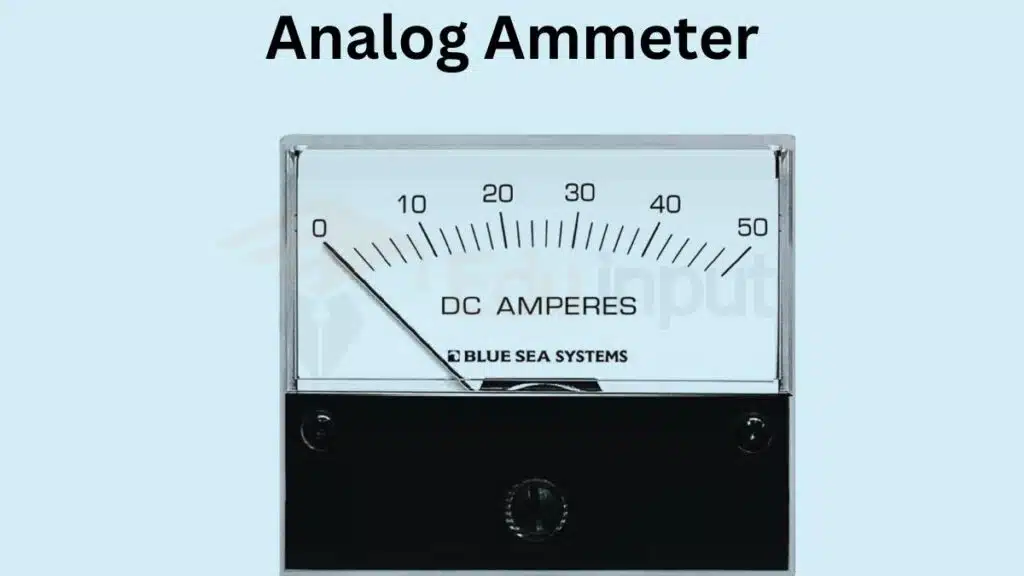Analog Ammeter-Working, Types, And Appliations
What is Analog Ammeter?
An analog ammeter is a measuring instrument used to measure the flow of electric current in a circuit. It is a type of ammeter that provides a visual indication of the current passing through it.

Analog ammeters have been widely used for many years and are still utilized in various applications despite the prevalence of digital ammeters.
Working of Analog Ammeter
Analog ammeters operate on the principle of electromagnetic induction. Inside the instrument, there is a coil of wire suspended within a magnetic field. When an electric current flows through the coil, it generates a magnetic field around it.
The interaction between the magnetic field of the coil and the external magnetic field causes the coil to experience a torque or rotational force, which deflects a pointer attached to it. The deflection of the pointer indicates the magnitude of the current flowing through the ammeter.
Types of Analog Ammeters
There are three main types of analog ammeters.
Moving Iron Ammeters
Moving iron ammeters use a soft iron vane or needle that moves in response to the magnetic field generated by the current flowing through the coil. The iron vane is attracted toward the coil, causing the needle to deflect.
Moving Coil Ammeters
Moving coil ammeters utilize a lightweight coil suspended in a magnetic field. As the current passes through the coil, it experiences a torque, causing the coil to rotate and deflect the pointer.
Hot Wire Ammeters
Hot wire ammeters consist of a fine wire that heats up when a current flows through it. The increase in temperature causes the wire to expand, which is translated into a deflection of the pointer.
Advantages of Analog Ammeters:
- Direct visual indication: Analog ammeters provide a direct and instantaneous visual indication of the current level, allowing for easy and quick readings.
- Simple and intuitive: Analog ammeters have a straightforward design and are easy to understand and operate, even for those without technical expertise.
- Wide operating range: Analog ammeters can measure a broad range of current values, making them versatile for various applications.
- Cost-effective: Analog ammeters are generally less expensive compared to their digital counterparts, making them a cost-effective option for many users.
Disadvantages of Analog Ammeters
- Limited accuracy: Analog ammeters have limited accuracy compared to digital ammeters. The readings can be affected by factors such as parallax errors, hysteresis, and nonlinear scale graduations.
- Susceptible to external influences: Analog ammeters are more prone to external magnetic fields and vibrations, which can affect their accuracy and performance.
- Difficult to read precise values: Analog ammeters typically have less precise scale graduations, making it challenging to read exact values. Estimation is often required.
Applications of Analog Ammeters:
Analog ammeters find applications in various fields, including
- Electrical power systems: Analog ammeters are commonly used in power distribution networks, substations, and control panels to monitor the current flow and ensure proper functioning of the system.
- Automotive industry: Analog ammeters are used in vehicles to measure the charging and discharging currents of the battery, as well as monitor the current flow in various electrical systems.
- Laboratory experiments: Analog ammeters are employed in educational and research laboratories for conducting experiments related to electrical circuits and current measurement.
Maintenance and Care of Analog Ammeters
To maintain the performance and longevity of analog ammeters, the following maintenance and care practices are recommended:
- Calibration: Periodically calibrate the ammeter to ensure its accuracy. Professional calibration services can be employed for precise adjustments.
- Cleaning: Clean the instrument regularly using a soft, dry cloth to remove any dirt or dust that may affect its operation.
- Storage: Store the ammeter in a clean and dry environment, protecting it from excessive humidity and temperature fluctuations.
- Avoid shocks and impacts: Handle the ammeter with care to prevent shocks or impacts that can damage its delicate components.
Troubleshooting Common Issues with Analog Ammeters
If you encounter issues with an analog ammeter, consider the following troubleshooting steps:
- Check connections: Ensure that the ammeter is correctly connected in the circuit and that all connections are secure.
- Test power supply: Verify that the power supply is functioning correctly and providing the required voltage for the ammeter to operate.
- Examine the scale: Inspect the scale for any damage or misalignment that may be causing inaccurate readings. If necessary, consult a professional for scale recalibration.
- Replace worn-out components: If the pointer, coil, or other mechanical parts are damaged or worn out, consider replacing them with new ones.
Future of Analog Ammeters
Although digital ammeters have become more prevalent in recent years, analog ammeters still have a place in certain applications. However, advancements in digital technology and the demand for higher precision and integration may limit the future growth of analog ammeters.
The focus is shifting toward smart and connected measurement devices, which offer enhanced functionality, remote monitoring capabilities, and integration with digital systems.
Related FAQs
What are analog ammeters used for measuring?
Analog ammeters are used for measuring electric currents in various applications. They are commonly employed in electrical power systems, control panels, substations, automotive systems, and laboratory experiments to monitor and measure the flow of current.
What is the range of the analog ammeter?
The range of an analog ammeter can vary depending on the specific model and its intended use. Analog ammeters are available in a wide range of current ratings, typically ranging from milliamperes (mA) to kiloamperes (kA).
Can analog ammeters be used for high-current measurements?
Yes, analog ammeters are available in various ranges and can be used for high-current measurements. However, it is important to select an ammeter that matches the desired range to ensure accurate readings and avoid damage to the instrument.






Leave a Reply